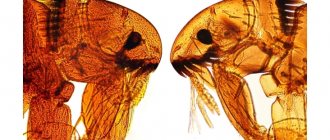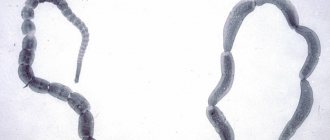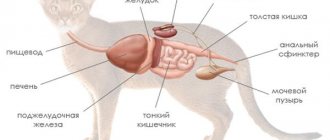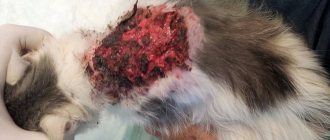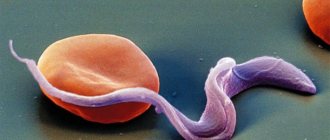Trichodectosis is a disease of domestic cats caused by infection of the animal with lice, often referred to in everyday life as lice.
This type of infestation is a less common variant of a cat becoming infected with parasites than the appearance of fleas. Cat lice are distinguished by a number of interesting features, including the specificity of their diet.
Unlike other parasites, these insects do not feed on the blood of the animal, preferring the cat's fur, as well as the upper layers of the skin. However, the manifestations of trichodectosis are typical for other forms of parasitic infestations.
The animal is bothered by severe itching, appetite and sleep are disturbed. Also, lice and lice eggs are potential sources of various infectious diseases and helminthiasis. How to protect an animal from infection and remove parasites if they have already appeared? Let's talk about this in more detail.
Do cats have lice?
As noted above, lice in cats are a fairly rare form of parasitic infestation. Much more often, the animal is attacked by other, no less unpleasant insects called fleas. Unlike several other types of lice, for example, human or rat, cat parasites are characterized by low resistance to the negative effects of external factors.
These insects cannot exist outside the host's body. Due to this feature, lice infection occurs exclusively through close contact between an infected and a healthy individual.
In addition, lice are slow to move and cannot jump or run.
Symptoms
A disease in which cats have lice is commonly called trichodectosis. At an early stage of the lesion, it is quite difficult to identify it, but we will present the most obvious symptoms:
- Itching - its intensity only increases every day, causing great discomfort to the animal. Watch your cat: lice infestation will make him restless and irritable.
- Sudden shedding has nothing to do with natural factors or seasonality. Clumps of fur fall out only in some places, forming bald spots.
- Nits - when you look closely at the fur and skin of an animal, you can easily see not only the parasites, but also the rich black color of the larvae.
- Redness and wounds - given that cat lice feed on the skin, wounds and abrasions appear quite quickly at the site of the lesion, which are simply impossible not to notice.
On light coats the described symptoms are more obvious. If you did not notice them at an early stage, and the disease acquired a jet form, the pet may be left without hair.
Can cat parasites be transmitted to humans?
Probably, almost every owner of an infected pet is interested in this kind of question - can lice pass from a person to a cat. These parasitic insects are specific, that is, their invasion of humans is not possible. A pet can be a carrier of lice, but an infected animal is only dangerous to members of its own species.
Are cat lice dangerous for humans?
Lice can live on cats for quite a long time - under favorable conditions, they do not leave the infected animal throughout its entire life, the total duration of which is no more than a month. Despite the fact that lice of this species cannot parasitize humans, they are potentially dangerous to humans. The danger lies in the risk of contracting infectious diseases or helminthiasis, which are carried by parasite eggs.
Fleas
Cats, kittens and cats are most often parasitized by canine (Ctenocephalus canis), directly feline (Cat felis) and human (Pulex irritans) fleas from the order Siphonaptera.
What do fleas look like on cats?
- Adult insects are wingless, the body is strongly compressed laterally, does not exceed 2-4 mm. Color ranges from light brown to almost black.
- The legs are long and strong. With high magnification, it is clearly visible that the legs are covered with numerous spines.
- On the head there are short, club-shaped antennae, which at rest are located in the recesses on the sides of the head.
- The mouthparts consist of interlocking jaws that act as thin spines that pierce the skin. Inside the spike jaws there is a natural “pump” adapted for blood sucking.
All three species have their differences, in the form of ctenidial spines of different lengths and numbers, but this difference is not visible to us and, in fact, is not important.
It is important that fleas are temporary parasites! This means that the flea will not constantly live on the cat, it will live in the external environment (carpets, furniture, cracks) and attack the domestic tailed cattle or your legs only when it is hungry and eager to hunt.
Surviving an attack by one or two fleas is quite possible, although unpleasant, but if a horde of these parasites has settled in the house, then being around is simply dangerous. Given their ability to reproduce quickly...
How do fleas reproduce on a cat?
Female fleas lay small, oval, whitish eggs, simply dropping them on whatever they are currently feeding on. The eggs do not have an adhesive shell and roll off wool, trousers, and bare skin onto the floor, upholstered furniture, bedding, and other fleecy objects or into inaccessible crevices. Moist, warm soil is also perfect for a flea “cradle”!
After a couple of weeks, under favorable conditions, these eggs will hatch into larvae with a thin, worm-like body, leading a free lifestyle and feeding on decaying organic debris.
After another couple of weeks, the larva pupates. 12 days after pupation, a new flea is “born”, ready to find prey and food.
Question: “Where does a cat get fleas, especially if he has the habit of walking on the grass?” – inappropriate. Staying on the owner for 2-3 hours after a bite, the flea enters your house on your pet (or on your legs), like on a taxi.
Even if you don’t have a cat, but there are fleas in the house, you shouldn’t believe in fairy tales about scary “grass” or “earth” fleas. Fleas are always the same, it’s just that the jump length of an ordinary flea is up to 2 meters. Ten jumps = 20 m. And here your threshold or window is open! Well, the theory about moving on your shoes or trousers is confirmed. To the question: “Where do fleas come from in the house, regardless of whether there is a cat there or not?” – the answer is obvious.
Both male and female fleas suck blood. There is no point in running away from home for a long time - outside the zone of its owners, this creature is capable of starving for up to 2 years.
There is only one way out - to rid not only your pet of fleas, but also your own home.
How to recognize lice on a cat
Cat lice are small in size and lighter in color than fleas. To determine whether a cat has lice, it is enough to observe the behavior of the animal. If it behaves restlessly, shows anxiety due to severe itching, it is necessary to examine the animal’s fur and skin. If there are small yellowish parasites, scratches, or small wounds on them, it is necessary to begin treatment immediately.
Symptoms of infection
Lice in cats often appear simultaneously with fleas, but they can infect a pet on their own. The following signs may indicate that a cat has pediculosis, or more precisely siphunculatosis (this is what infestation with lice eaters is called):
- severe itching - lice bite off pieces of skin, constantly injure the cat and cause it to itch continuously;
- the appearance of bleeding wounds, abrasions, scratches - both from bites and from scratching;
- shedding - the animal begins to shed its fur, and this is not similar to seasonal shedding: bald spots appear in certain places;
- upon careful examination, you can see accumulations of insects, their excrement, remains of shells, and nits;
- anxiety - the cat behaves unnaturally, constantly itches, rubs itself on its legs and furniture, sleeps poorly, etc.
Methods for getting rid of lice and nits
So, if a cat has lice, how to get rid of these unpleasant parasites, what to do if infected?
Treatment at home is carried out through the use of various insecticides that have a detrimental effect on adult parasites and eggs. When choosing the most suitable active ingredient, it is recommended to take into account factors such as age and degree of infection. If there are other parasites, for example, lice, comprehensive treatment should be carried out.
Emulsoids
To remove parasites from cats, it is recommended to use various types of emulsoids. Products in this group for the treatment of head lice in cats are intended for diluting the concentrate in water and then applying it to the animal’s fur. The drug is quickly absorbed into the skin. When the parasite comes into contact with this substance, the insect dies.
A significant disadvantage of lice emulsoids is their high toxicity and potential danger to the animal. Contact of insecticides with the eyes, skin, or oral cavity can cause acute intoxication of the animal. In addition, such drugs remain effective for a limited period of time.
Drops and sprays
To remove adult individuals and nits from cats, you can use various drops and sprays that have somewhat similar effects. Lice drops for cats, for example, are intended to be applied to the withers area. They are almost instantly absorbed into the skin and retain their toxic effect for several months. When processing, you should strictly monitor the area where the drug is applied, since licking off the drops may result in acute poisoning.
Anti-lice sprays are also designed to treat hair in the area of the withers and spinal column. Aerosol medications are essentially improved emulsoids. Unlike the latter, sprays remain effective for several months. Due to the specific nature of the treatment, the risk of poisoning is extremely low.
Collars and shampoos
If a kitten has lice, it is recommended to remove them by using shampoos. These products are particularly gentle and non-toxic. Their significant drawback is the lack of a prolonged, destructive effect on parasites. The components included in their composition repel lice, but the risk of re-infestation cannot be excluded.
To prevent infection of your pet and eliminate existing lice, it is recommended to use special collars made from materials that contain various insecticides. As a rule, the use of collars is recommended for the treatment of pets whose age is more than two months. The device must be changed periodically due to the fact that the active components lose their effect.
Treatment of dermatitis
The cat louse feeds on hairs and particles of the animal's skin, which causes severe itching. When scratching itchy areas, the animal introduces infection into existing wounds, which leads to the development of inflammation and dermatitis. If your cat has lice or small ulcers appear on the skin, treatment should be started immediately.
The main methods are the following:
- the use of anti-inflammatory drugs that prevent the spread of pathological processes and help eliminate them.
- Antiseptics. They should be used to provide a disinfecting effect.
- Antimycotic.
- Healing. They should be used to stimulate the regenerative abilities of tissues and more quickly restore the skin.
It is recommended to comprehensively use products that help eliminate pain and itching. This measure will help improve the condition of the animal.
How are cat lice different from lice and fleas?
So, we have already figured out that cat lice are called hair lice. Why? In fact, lice and lice eaters have a lot in common: they have a light yellow tint, are characterized by a small elongated body, and use the host’s food not only for food, but also for subsequent reproduction, laying eggs in the fur. The only difference is the power source. Lice feed on blood and bite people, while lice eaters are interested in skin and fur. So cats are susceptible to parasitism by lice eaters.
Now regarding fleas. They use the mammal exclusively for food, laying their eggs in more secluded places, most often under carpets and rugs. The female flea feeds on blood before laying eggs. In the absence of a food source, a flea can starve for up to several months. That is why. Even if you are away from home, having rid your pet of parasites during this time, when you return, the flea will begin its rapid defeat again.
Lice eaters differ from fleas in that they are also inactive: they will never jump like that. That is why, if you find completely inactive light yellow parasites on the skin of a cat, without a doubt you are dealing with lice eaters.
Rules for removing lice from cats
If an animal has cat lice, antiparasitic treatment must be carried out following certain rules. First of all, it is important to exclude the possibility of contact of the animal with a toxic substance. To do this, you can put a special restrictive collar around the cat's neck. Otherwise, the necessary actions are prescribed in the instructions for the selected drug.
It is important to remember that some insecticides do not have a detrimental effect on parasite eggs, which are protected by a dense capsule.
Accordingly, to prevent the reappearance of insects, it is necessary to carry out additional treatment of the cat two weeks after the first procedure.
Symptoms and routes of infection by lice eaters
Any cat can become infected, even if it does not go outside - people can bring parasite eggs into the house on their shoes, for example. It is also possible for a groomer to become infected through untreated cat grooming tools. But the greatest risk is for pets who walk outside or interact with other animals, some of whom may have trichodecosis. There is also a transmission of lice from mother to child.
Cat lice are not easy to notice because they hide in the fur, and the symptoms of infestation are also typical for other skin lesions:
- severe itching;
- wounds, scratches as a result of scratching;
- nervous and irritable state of the cat due to unpleasant sensations;
- hair loss, bald patches.
The parasites were called lice-eaters precisely because of the baldness of the sick animal, although in fact cat lice do not feed on hair.
Trichodecosis is not easy to detect if the animal is simultaneously infested with fleas, since the symptoms of these conditions are similar. In any case, when a pet itches or tries to bite something in its fur, it should be carefully examined, even if it seems that the cause of the itching is clear. Upon inspection you will notice:
- small black dots - excrement of lice eaters;
- whitish eggs of the parasite attached to the fur;
- adults.
Lice eaters are not microscopic insects; they can be seen with the naked eye
To make sure there are lice eaters, you can also place the cat under a lamp or sunlight. When the fur heats up, heat-loving parasites will rise to the ends of the hair.
Video: skin diseases in cats - advice from a veterinarian
How harmful are lice to a cat?
The appearance of lice in a cat is fraught with the development of dangerous consequences for the animal. Severe itching provokes cat anxiety, lack of appetite, and sleep disturbances. When an animal scratches itchy areas, an infection may occur, which can cause inflammation and the appearance of wounds. Against the background of a significant number of parasites, the cat’s hair loss occurs, up to complete baldness.
Lice are especially dangerous in kittens. Infection with these parasites can cause the death of the animal. The main factor that can lead to such unfavorable consequences is the infection of the cat with various types of helminths, the carriers of which are lice. Infection occurs when eggs or adult parasites enter the animal's digestive tract.
Are fleas and lice from cats dangerous for humans?
Entomotic invasion is unpleasant in itself, but its consequences are worse - insects are mechanical and biological carriers of other diseases, such as:
- worms;
- allergies;
- dermatoses;
- eczema;
- phlegmon;
- fungal infections;
- infectious diseases.
In addition, cats become very restless, scratch, scatter parasites and their eggs around them, and bald spots and abrasions form at the scratching sites. In the fight against parasites, cats are deprived of rest, their attention and obedience decrease, and they become irritable. All this leads to general mental and physiological exhaustion, which can lead to the death of the animal.
Young cats are more susceptible to attacks by fleas and other entomoses, suffer from invasion more severely, and die 5 times more often from exhaustion or from feline distemper (Panleukopenia), receiving the virus through a flea bite.
Panleukopenia is not dangerous for humans, however, if there are other cats (especially kittens) in the house, infection with parvovirus eneteritis is almost inevitable. Calcivirosis or rhinotracheitis are not completely excluded.
Viral diseases of cats are not dangerous to humans. The same cannot be said about microfungi such as Microsporum and Trichophyton, which readily settle on scratches. Ringworm is already dangerous for humans.
When examined, half of the street cats infected with entomoses are found to have spores of diaphoretic fungi.
The cat flea, as we found out, cannot live on humans. But she can live nearby, jumping on you from time to time to make a “hole”. But the consequences of a bite can be different.
Firstly, the enzymes (about 20 of them) that the flea injects into a tiny wound to prevent blood clotting until the insect is satiated can themselves cause an allergic reaction in the form of fever, swelling at the bite site and even anaphylactic shock. This reaction to insect bites is called pulicosis.
Pulicosis is especially dangerous for children and older people.
By mechanically scratching an open wound, you can unwittingly introduce a serious infection into it. And this infection will only be secondary. The primary one will be “gifted” to you by a flea by making a tiny puncture on your skin.
As for lice and lice eaters, these creatures do not live on humans, unless, of course, they are human. A person, in turn, has a number of similar insects with which he cannot infect his pet, fortunately.
But it’s probably unpleasant for anyone to realize that your animal is parasitized by all kinds of vile creatures, which, when feeding from a tiny wound, are screwed into it almost entirely, leaving only 1/3 of the disgustingly fatty abdomen on the surface.
There can be only one conclusion - parasites must be destroyed without pity and compassion! And it’s quite possible to remove fleas from a domestic cat!
Prevention
After treating a cat for lice, it is important to resort to preventive measures that will somewhat reduce the likelihood of the animal becoming infected in the future. This requires the use of anti-parasitic collars, which are important to change as needed.
The state of health of the skin is important. Healthy, clean skin, free from scratches and wounds, prevents the rapid proliferation of parasites. To keep your pet healthy, you need to feed it a balanced diet, avoid contact with infected pets, and conduct periodic coat checks.
The main sign that indicates a lice infestation is the appearance of whitish nits and dark spots on the skin and fur, which are products of the vital activity of parasites.
Even if their number is insignificant, it is necessary to immediately take measures aimed at destroying lice.
Methods for controlling cat lice
There are both special medicinal preparations that are effective against lice eaters, and folk remedies to combat them.
Special preparations
As a rule, to combat cat lice, universal insecticides against external parasites are used, which are also effective against fleas and sometimes ticks. It is advisable to select them in consultation with a veterinarian, because only he can prescribe the drug, taking into account contraindications and the general health of the cat.
There are general principles for the use of one or another type of product, however, each must be used strictly according to the instructions on the package or on the recommendation of a veterinarian - depending on the manufacturer and the specific situation, there may be nuances. When processing, you need to remember the general precautions:
- do not exceed the recommended dosage;
- make sure that the product does not get inside the animal, as it can become poisoned by licking the drug from the fur;
- Any cat can have an individual intolerance, so if your pet feels unwell after treatment, you need to stop contact with the product and contact a veterinarian.
Perhaps the most convenient form of releasing drugs against external parasites is drops on the withers
Table: drugs against lice eaters
| Type of drug | Name | Features of the composition | Approximate price (according to Yandex.Market) | pros | Minuses | Application principle |
| Shampoos | RolfСlub | Active ingredient: permethrin | 250–340 rub. |
|
|
|
| "Celandine" | The active ingredient is permethrin, there is an option with lavender | 107–150 rub. | ||||
| "Phytoelite" | The active ingredient is permethrin, supplemented with decoctions of wormwood and celandine. | 91 rub. | ||||
| "Lugovoy" | The active substance is deltamethrin, there is an option with the addition of medicinal herbs (chamomile, calendula, coltsfoot) | 120–170 rub. | ||||
| Sprays | "Leopard" | Active ingredients:
There is also a version of Forte with only fipronil. | RUR 213–316 | Usually it not only destroys lice eaters, but also protects the cat for some time after treatment (usually a month) | Not a very easy method of application: there is a risk of getting on the cat’s mucous membranes |
Products based on natural ingredients, for example, Ms.Kiss, are applied every day (possibly several times), because they do not have a long-term effect. |
| "Frontline" | Active substance - fipronil | 1085–1660 rub. | ||||
| Ms.Kiss | Active ingredients: essential oils of citronella and lavender | 200–260 rub. | ||||
| Drops | Bayer "Advantage" | Active ingredient: imidacloprid | 650–1450 rub. |
| Most of the products have a relatively high price | The drops are applied to the skin of the back of the cat's head, after parting the fur. Manufacturers recommend applying it between the shoulder blades, but some cats are able to reach this place with their tongue, so it’s better not to risk it. |
| Frontline "Combo" | Active substances:
| 470–600 rub. | ||||
| "Four with a tail" | Active ingredients: essential oils of citronella, lavender and schizandra | 97 rub. | ||||
| Collars | Agrovet protection "Fitodok" | Active ingredients: essential oils of citronella, lavender, eucalyptus, margosa, tea tree | 200–260 rub. |
|
| The collar is put on the cat so that there is a gap of 1–1.5 cm between it and the neck. |
| "Leopard" | Active component - fipronil | RUR 141–160 | ||||
| "Celandine" | The active substance is diazinon, there is a Bio option with citronella oil, as well as Maximum with fipronil, permethrin and lavender | 42–70 rub. |
You cannot combine different drugs. In some cases, this can only be done after consulting a veterinarian.
Photo gallery: special preparations to combat lice eaters
The rich line of Fitoelita shampoos also includes an insecticidal option.
The Celandine shampoo with lavender combines the action of a natural repellent and the insecticide permethrin
Lugovoy shampoo is available for both cats and dogs, and only for cats
RolfСlub shampoo is effective against fleas and lice
Thanks to its natural composition, the spray against ectoparasites can be used by kittens 3 weeks of age and above.
Frontline spray is suitable for kittens from 2 days of life
Advantage drops are available in several versions depending on the cat’s weight
The active ingredients of the drops “Four with a tail” are essential oils
Frontline drops are effective against fleas, ticks and lice
The effect of the “Fitodok” collar against parasites lasts up to 3 months
The Celandine collar exists in several versions, in particular, Maximum contains lavender in addition to insecticides
The Bars collar is insectoacaricidal, which means it protects against both fleas and ticks. The Bars spray also protects against ticks.
Reviews of remedies for cat lice
I have two cats. And sooner or later, they will be attacked by some pests. Cats are completely indoor cats and don’t go outside anywhere, but they still managed to catch some rubbish. The cat licked his belly so much that bald spots formed. The situation with the cat is also not stable. It seems to be itching, but it doesn’t seem to be. As a result, I discovered some small black flies on the cat. They don't look like fleas at all. Frontline was recommended to me. It is one of the expensive ones, but effective. I have taken it more than once and know about the positive results. For your pets, because... There are two of them, I bought two packs.. Why save money!!! It came out to around 1100 rubles. The pipette with the solution itself is easy to open. You need to unscrew the top part with your fingers. The liquid has no odor. Transparent. It looks like water!!! A very important point is application. You yourself know that cats actively lick themselves and if you apply Frontline incorrectly, the animal can lick it off and get poisoned. The most correct place is between the shoulder blades!!! It’s very difficult for a cat to get there!!! And now about the important thing, about saving Bori and Bonya from their unpleasant neighbors. The cats actually began to itch less by the evening. We slept peacefully, without trying to bite or gnaw ourselves. I believe that Frontline has proven to be an effective tool. After just a week, all the symptoms disappeared! The animals sleep peacefully, do not itch and are very good-natured!
Nastya259
https://irecommend.ru/content/otzyv-o-realnykh-rezultatakh-spasenie-dvukh-koshakov-pokazhu-kuda-nanosit-frontlain
We bought “Clandestine” shampoo; it is suitable not only for cats, but also for puppies. It is intended not only against fleas, but also against lice and lice. On the back of the package there is a description of the product and method of use: Storage conditions and composition: The packaging is convenient, there is a hinged lid: / The shampoo does not have an unpleasant odor, although I expected it to be very sharp and chemical. But no, it has practically no smell at all; no smell remains on the wool after use at all. Its consumption is very economical! You only need a few drops at a time, based on the weight of the animal, carefully read the instructions. But we added a little more than what was said there, it didn’t make it any worse. The shampoo foams well, but the foam quickly disappears and seems to be absorbed into the hair. Shampoo does not work miracles; it will not rid the animal of various parasites in one go. In general, in such cases you need an additional remedy, for example, drops or a spray. The first time, the number of fleas and lice-eaters decreased, but the shampoo did not completely get rid of them. With each wash, their quantity decreases, so I can say that the shampoo copes with its main task.
Alisa Novickova
https://otzovik.com/review_5230685.html
I have never encountered lice eaters in cats before. I heard about them, read on the packages of insectoacaricidal products, but I believed that my animals simply could not have this infection by default. My favorite cat Woof got itchy. They chalked it up to allergies, because he definitely doesn’t have fleas, and he knows how to beg for chicken (a strong allergen)... When one not-so-wonderful day I discovered scratches above Zhorka’s eye and a bald spot behind Gavka’s ear, the first thought was a cat fight... And then I discovered something like dandruff around Gav’s “tuft torn out in a fight” and then a doubt crept into my mind... that some elusive moth was eating the velvet coats of my fluffies... A trip to the veterinarian put me in a dead end: my cats were attacked by lice eaters! Where does this scourge come from? Cats don’t go outside... unless we brought something on our feet?... Having shaken out the home cat’s first aid kit, I found Bars insectoacaricidal drops, which I usually used to prevent flea infestations. Gavka, seeing the “Leopard” box, immediately turned from a cat into a bristling leopard: he doesn’t like executions with aromatic products, so he had to handle it together. It’s good that the product comes in convenient droppers! Following him, the rest of the cats were processed. After 2 weeks, I can say that Gavka and Zhorka’s scabies have stopped, the scratching areas have healed, and even Gavka’s bald patch seems to have started to grow new fur.
Lalika
https://otzovik.com/review_6550055.html
Folk remedies
Traditional methods of treatment for lice eaters are not very effective. They should be used if single parasites have been noticed, for prevention, or in cases where the use of special means is impossible due to the cat’s health condition. The same methods are used as for removing fleas. The safest and most effective for the animal is bathing in a decoction of herbs:
- wormwood;
- sequences;
- chamomile;
- lavender;
- tansy;
- rosemary.
Prepare the decoction as follows:
- Take 1.5 tablespoons of dried herbs per 400 ml of boiling water or 40 grams of fresh herbs per 250 ml. You can mix several herbs in compliance with the proportions of raw materials and water.
- Place the mixture on the fire and bring to a boil.
- From the moment of boiling, wait 5–10 minutes and remove from heat.
- Cool.
- The resulting decoction is rubbed into the skin and fur of the cat. Don't wash it off.
Additionally, these plants can be placed in your cat’s favorite places. The treatment is repeated as necessary every week or two until the parasites completely disappear, and in the future for prevention.
The pet's bedding, house and other favorite places should also be treated; you can fill the pet's bed with pine sawdust.
Folk remedies also include mechanical removal of cat lice - combing the cat with a fine-toothed comb. Do this every 3-4 days. However, the method is ineffective; it is advisable to use it only as an addition to others.
Photo gallery: herbs for external parasites of cats
Wormwood, known as a weed, is a powerful remedy against external parasites.
Lavender has a scent that is pleasant to humans, but not tolerable to cat lice.
Tansy also repels ticks
Chamomile also has an antibacterial effect
Rosemary can be bought in supermarkets
The series has a mild effect, suitable for animals with sensitive skin
Features of treatment of kittens and pregnant cats
Almost all of the drugs listed are suitable for kittens from 2–3 months of age. But for pregnant and lactating cats, as well as babies under 2 months old, the manufacturer recommends only Frontline spray - it can be used by kittens from two days of life. Also, for the listed categories of pets, you can use the mentioned folk remedies; there are no direct contraindications, however, for pregnant cats, it is advisable to choose herbs with a mild odor, for example, chamomile.
Video: how to choose a remedy for external parasites - advice from veterinarians
Treatment
Left untreated, lice in cats threaten the animal with baldness. In advanced cases, dermatitis and inflammatory skin diseases begin. This weakens the cat’s immunity and increases the risk of contracting various infections.
To treat lice in cats use:
- shampoos;
- sprays;
- drops.
The choice of drug, its form and dosage are discussed with the veterinarian. When treating your pet, strictly follow the instructions and adhere to all safety measures.
It is important that the cat does not lick the antiparasitic agent from the fur and skin. This will lead to serious poisoning. If your pet exhibits strange behavior after treatment, contact your veterinarian immediately.
What you should be wary of:
- Lethargy, unsteadiness of gait.
- Vomiting, convulsions, dilated pupils.
If there are small children at home, you need to isolate the treated animal from them. It is difficult to explain to kids that the cat cannot be petted yet, as there is a high risk of poisoning.
Lice shampoos
Shampoos are considered a gentle treatment against parasites. They are used to remove lice from pregnant cats and small kittens, and from animals with contraindications to more toxic drugs.
Shampoos work well with mature individuals, immobilizing parasites. After bathing, they are combed out with a comb with frequent, fine teeth. The cat is placed on a white cloth or a sheet of paper is placed under the pet. The wool is divided into small strands and carefully combed.
Several procedures are required to kill nits. To completely get rid of parasites, 2–3 treatments are required. They are carried out 7-14 days apart
Lice sprays for cats
Sprays are used when the animal is severely affected. The concentration of active components in them is maximum. They can cause side effects such as vomiting and seizures in the cat. When they appear, contact a veterinarian.
The spray is applied to wet wool against hair growth. The balloon is kept at a distance of 20 centimeters from the pet’s body. Before treatment, a protective collar is put on the cat. The spray is distributed starting from the neck throughout the cat’s body.
During the next 24 hours, it is forbidden to wash your pet. It is necessary to limit his contact with children. After touching the cat, it is better for the owner to wash their hands to avoid poisoning.
If necessary, the cat is re-treated. It is valid 30 days after the first one.
Drops to combat lice
The drops allow you to remove not only lice from your cat, but also fleas and ticks. The active components accumulate in the fatty layer of the skin and have a long-lasting effect. After treatment, the animal will not pick up parasites for another month or two. The period depends on the manufacturer of the drug.
Drops are applied to the withers and along the entire length of the spine to the ridge. To prevent the cat from licking the medicine, a protective collar is put on the animal. Re-application is usually not necessary. But if necessary, treatment is repeated after 10-14 days.
After treatment, avoid contact of the pet with water for two or three days. More precisely indicated in the instructions for a specific drug.
A cat has lice: how to get rid of them at home
To rid a cat of lice, complex insecticides for pets are often used. Before purchasing them, you need to carefully study the instructions and make sure that this drug destroys not only fleas and ticks, but also lice that parasitize cats.
special shampoos, sprays or drops on the withers are used to kill parasites . Collars are more intended to prevent infection, and not to treat the animal from parasites, therefore, they should be used only when there are no live lice, eggs or larvae left on the cat’s body.
The drugs are used strictly according to the instructions, and it is necessary to strictly adhere to the dosage recommended by the manufacturer, as otherwise it can cause serious harm to the health of the pet. The general principle of using products to rid cats of fleas is as follows:
- Drops. They are applied to the cat's withers, where she cannot lick herself. First, you need to move apart the animal’s fur in the areas where the drug is applied. It must be remembered that an overdose of drops can be dangerous for the animal. In no case should you pour the entire preparation contained in the package onto the withers: you need to apply as many drops to the skin as indicated in the instructions.
- Spray. Sprays onto the cat's fur. Depending on the brand of the drug, after such treatment you cannot wash your pet for some time (from a couple of hours to several days), and you may also have to temporarily prohibit children from playing with the animal and petting it.
- Shampoo. Apply to dry or damp cat fur, then foam and rinse with warm water. This method is not suitable for all cats, since only a few of them like to bathe, and this can cause certain difficulties when treating your pet for parasites.
IMPORTANT! One treatment is not always enough to completely destroy lice, so if the animal continues to show symptoms of infection, the procedure will have to be repeated in about a couple of weeks.
When should you take your pet to the vet?
Will you take your cat to the vet?
Not really
If the infestation is not severe, you can usually manage your pet’s lice on your own. It’s another matter if the disease is advanced and serious complications appear, for example, dermatitis or eczema. In this case, you cannot do without the help of a veterinarian, since in addition to specific insecticidal agents, you will also have to use antiseptics or wound-healing drugs. They should be prescribed by a doctor; self-medication can only worsen the pet’s condition.
In addition, in the case of a serious lice infestation, the cat may develop anemia and worms. The animal's body is weakened and becomes more vulnerable to toxic substances included in insecticidal preparations. Therefore, you should consult with a veterinarian who will select the product that is safest for your pet.
The same applies to small kittens: it is unacceptable to try to rid them of lice on your own, since babies are especially vulnerable to toxic substances and the wrong drug can lead to serious poisoning.
IMPORTANT! A pregnant or lactating cat, as well as an elderly, sick or weakened pet, cannot be treated for external parasites on your own: a doctor should also prescribe remedies for getting rid of lice for them.
- about the author
- VK profile
